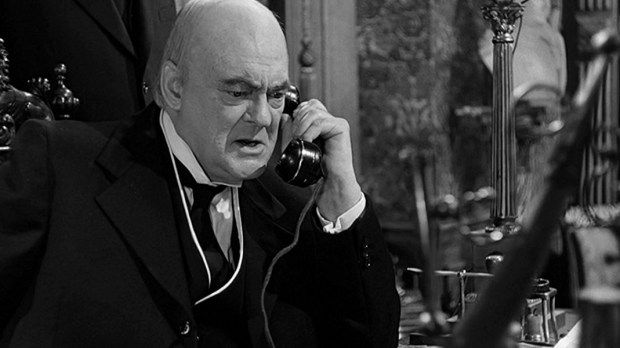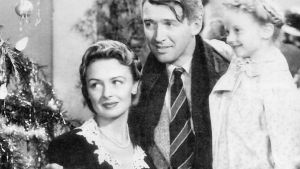One of the few benefits of a sick home the week of Christmas is that it’s a great opportunity to watch the Christmas classics. For me, this had to mean returning to what has rightly been hailed as the greatest Christmas movie of all time: It’s a Wonderful Life. After watching the film in the black and white of the original theatrical release late at night, I convinced the family to watch the colorized version together the next day.
It took some work, the convincing: When I began laying out the plot to my kids, my nine-year-old asked — not unreasonably — “But how is that a Christmas movie?” Indeed, what struck me this year is just how much of the film gives us the George Bailey’s backstory. It is not until more than halfway through the runtime that we get to that infamous Christmas Eve where George’s life falls apart. And it is only in the last half hour that the angel Clarence guides George through the alternative universe in which he had never been born.
What is the great beauty of this story? Part of it, of course, is the focus on the dignity and value of the individual — a theme accentuated by the dark turn of George contemplating suicide and wishing he had never been born at all. When George, in the tradition of The Christmas Carol, is given a glimpse of this world, he sees the “awful hole” that would be left if he were to vanish. Everyone matters, the film reminds us; no one is dispensable.
And part of it is also, as Andrew Petiprin notes in Popcorn with the Pope, the film’s celebration of solidarity — the “social charity” that spreads temporal and spiritual goods for the sake of the common good. From George’s work for the Building and Loan, to the ongoing struggle with old man Potter, to Clarence’s parting note to George, there is a strong emphasis on the virtuous upbuilding of friendship and community.
But between these two great themes — the person and society — is, I think, the central theme of It’s a Wonderful Life: the family, which Catholic social teaching calls “the first natural society.” After all, the focus of the whole first hour of the film is George’s great desire to be a solitary globetrotting explorer running into his pull toward family: toward his father and his business, toward his brother and his own trajectory, and most of all, toward Mary Hatch and her love for him — a love enthusiastically cosigned by his mother, with all signs pointing toward settling down in Bedford Falls for good. “I don’t want to get married ever to anyone,” a conflicted George snaps at Mary. “I want to do what I want to do.”
George gives up Tahiti and Venezuela and the Yukon for Mary and marriage and kids, and it makes all the difference — not only to the man George becomes but to how he becomes him. It is Mary who has the idea to front their honeymoon money during the bank run and who secures their broken-down house afterward (“You’re wonderful,” George whispers to her by the fire. “You’re wonderful”); it is the blood on his lip left by the mean right hook of Mr. Welch — Zuzu’s teacher’s husband — and the petals from Zuzu’s flower that ground him in reality. The most heartwrenching scene has George falling apart in front of his wife and other three kids, questioning whether they should have had them all in the first place (“You call this a happy family? Why did we have to have all these kids?”); and the most heartwarming scene finds George embracing Mary on the staircase surrounded by their four little ones later that night — a scene captured in that iconic cover image. When George returns to reality, he immediately rushes back home to his wife and children, and though the family is surrounded by the generosity of friends and loved ones, it is once again Mary who has organized things: “Mary did it, George!” Uncle Billy exclaims. “Mary did it!”
It is not enough to say that It’s a Wonderful Life celebrates the beauty and the goodness of the natural family; it celebrates its holiness. The sacredness of George and Mary’s marriage bond and the fruit it bears is accentuated by religious imagery and themes that appear throughout the film — George’s prayer to God, the presence of angels, the Martinis signing themselves with the cross, a brief glimpse of the Mass — but none so much as the recurring presence of the Holy Family itself: Jesus, Mary, and Joseph. The three names are invoked in the opening prayers of the film; George’s wife, of course, is named Mary, and the angel guiding Clarence’s mission on earth is named Joseph; and Zuzu’s rose is a powerful symbol of Mary, while her name — though apparently inspired by Zu Zu Ginger Snaps — comes from the Czech for “lily,” a flower associated with St. Joseph. The birth of the God-man to the impoverished Mary and Joseph is the ultimate reminder that the struggle of family life has — like all things earthly — been sanctified by the divine presence.
It’s no secret that both marriage and birth rates have been in a steep decline since the bygone era of It’s a Wonderful Life. Today, almost half of millennials have not settled down, and couples are increasingly having children in fewer numbers, later in life, or even not at all. Against these trends, It’s a Wonderful Life stands as a beautiful source of encouragement: When it comes to having and raising a family, don’t be afraid, and don’t wait too long to get started. It’s a wonderful life.


